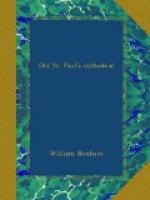The heart of England was alienated from a religion which had resorted to such brutalities, and the doctrines of the Reformation were everywhere received. Queen Elizabeth, however, would not be incautious. There was no immediate interference with the Marian ceremonial. There was a solemn Requiem Mass sung at St. Paul’s after the death of Henry II. of France, July, 1559, but by this time the restored images had again been removed. One day, when she came to St. Paul’s, Dean Nowell placed in her pew a prayer-book richly illuminated with German scriptural engravings. She was very angry, and demanded to know who had placed “this idolatrous book” on her cushion. The poor Dean explained, and her Majesty was satisfied, but “prayed God to give him more wisdom for the future.” She expressed her satisfaction that the pictures were German and not English. Some years later the same Dean offended her in the opposite direction. It was on Ash Wednesday, 1572; he was preaching before her, and denounced certain “Popish superstitions,” among them the use of the sign of the Cross. Her Majesty called out to him sternly to “stick to his text.” The next day he sent her a humble apology.
Paul’s Cross was silent for some months; when at length it was again occupied the Reformed faith was reasserted. Bonner was sent to the Tower, and the English Communion service was again in use. In the following August, the Queen’s Commissioners held a Visitation in St. Paul’s, at which all who refused to conform with it were pronounced contumacious and deprived. The rood was again turned out, as were the images, and now it was with the approval of the people at large. In many places there was much violence displayed in the destruction, but not in St. Paul’s. All was done there without tumult, and with discrimination. On December 17th, 1559, Parker was consecrated Archbishop at Lambeth, and four days later he consecrated Grindal Bishop of London. Bonner was sent to the Marshalsea Prison, which Strype declares was done to screen him from the popular detestation. He was well fed and housed there, and had “much enjoyment of his garden and orchards,” until his death in 1569.
Grindal had been warmly attached to Ridley, and still loved his memory dearly. Moreover, he had himself been an exile for his opinions. He was not, therefore, likely to look favourably upon the old ceremonial, even in its modified form of stately solemnity and grace, such as Tallis and Merbecke would have preserved to it. And his Dean, Nowell, had the same distrust. Had they favoured it, in all probability the moderate and beautiful rendering of the Liturgy, as it is heard in the cathedral in our day, would not only have won the affections of the people at large, but would have arrested the strong tide of Puritanism and iconoclasm which was now rising. In Convocation, the Puritans nearly carried the removal of all organs from churches. They lost it by a majority of one, and Dean Nowell was in the minority.




